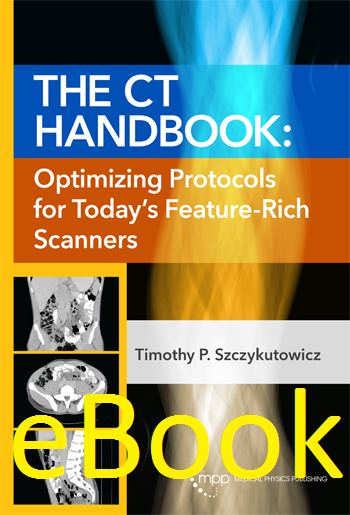
The CT Handbook: Optimizing Protocols for Today's Feature-Rich Scanners
Author: Timothy P. SzczykutowiczISBN: 9780944838570
Published: May 2020 | 580 pp | eBook
Price: $ 165.00
IPEM Scope | WINTER 2020
The CT Handbook
Laurence King, Principal Clinical Scientist at Royal United Hospitals Bath NHS Foundation Trust, gives on overview of the new publication by Timothy P Szczykutowicz.
There are many textbooks on computed tomography that provide a good technical guide on the physics and functionality of modern scanners, including those by Kalendar, Samei and Pelc, and Buzug. However, none of these are aimed as a day-to-day reference for the practicing medical physicist, with as much clinical insight as technical information. This is the aim of Tim Szczykutowicz’s handbook, which attempts to embody all the concepts that a medical physics expert should understand with respect to CT optimisation.
The CT Handbook very impressively conveys an appreciation of specific CT capabilities and features, clinical workflows and scan techniques, radiology networking and informatics, and the language to effectively communicate with radiologists and radiographers. It contains a wealth of practical advice and examples to draw on.
The book begins with an obligatory chapter on an introduction to CT, but instead of covering the familiar physics background it progresses fairly swiftly to example clinical workflows, commonly used anatomical landmarks, and the clinical significance of image quality metrics. In the next few chapters, protocol parameters, such as reconstruction options, scan mA and pitch, are dealt with in turn, describing the image quality implications of scan protocol decisions with plenty of clinical images to back up the text.
A chapter of almost 30 pages is dedicated to automatic tube current modulation, with plenty of insights into the main four vendors’ specific implementations. Further chapters deal with use of iodine contrast, kV selection, then 35 pages on robust protocol management and review, including overviews of dose management software (a chapter dedicated to radiology networking and informatics follows later), and common pitfalls of performing dose audits of multi-series CT protocols.
A chapter on clinical CT includes patient positioning techniques, the various cardiac CT gating strategies, commonly requested image reformatting and considerations for paediatric imaging. This goes a long way in giving a physicist the language and understanding needed to have meaningful conversations with radiologists about specific imaging requirements.
A lengthy chapter on artefacts is wonderfully illustrated with many clinical examples and, lastly, follows a buyer’s guide to CT, including common features and ancillary equipment to consider – potentially very useful for MPEs who by law in the UK are required to contribute to equipment specifications.
This text is written from a US perspective, so it loses just a little relevance in the UK in a few places: use of patient shielding is discussed, although recent UK guidance advises it should not be used in the majority of situations, and DLP-to-effective dose conversion factors from various sources are presented, but without the updated conversion factors of Shrimpton et al that are commonly used in the UK and recommended by the HRA for research study review.
These points aside, the unique selling point of this handbook is it comes from a practical and clinical perspective, aimed at the physicist who wants to dive into clinical optimisation. It contains concepts and practical pieces of advice that I have taken years (sometimes painfully) on the job to appreciate. This textbook is not aimed at providing technical theory, nor as an update to familiar references. Instead, it is a practical and pragmatic handbook that will give medical physicists much of what they need to know to immediately begin working more closely with clinical colleagues to effectively optimise CT protocols.
I can recommend this handbook for both experienced and aspiring MPEs alike.


